Stepping into Lijiang, where visitors linger
What comes to mind when you think of Lijiang? Perhaps majestic mountains and rivers, picturesque scenery brimming with flowers and lush greenery, enchanting and vibrant ethnic customs, and a rich, deeply rooted history and culture. These captivating attributes propelled Lijiang City, Yunnan Province, to quickly become a highly popular destination for residential tourism in China during 2024. The city welcomed a total of 80.64 million tourists throughout the year, an increase of 18.45% year-on-year. Notably, international tourist arrivals soared to 662,800, a remarkable surge of 205.64% compared to the previous year. This burgeoning interest highlights that an increasing number of visitors are not just coming to Lijiang, but choosing to stay, immersing themselves in Yunnan’s many-splendored life.
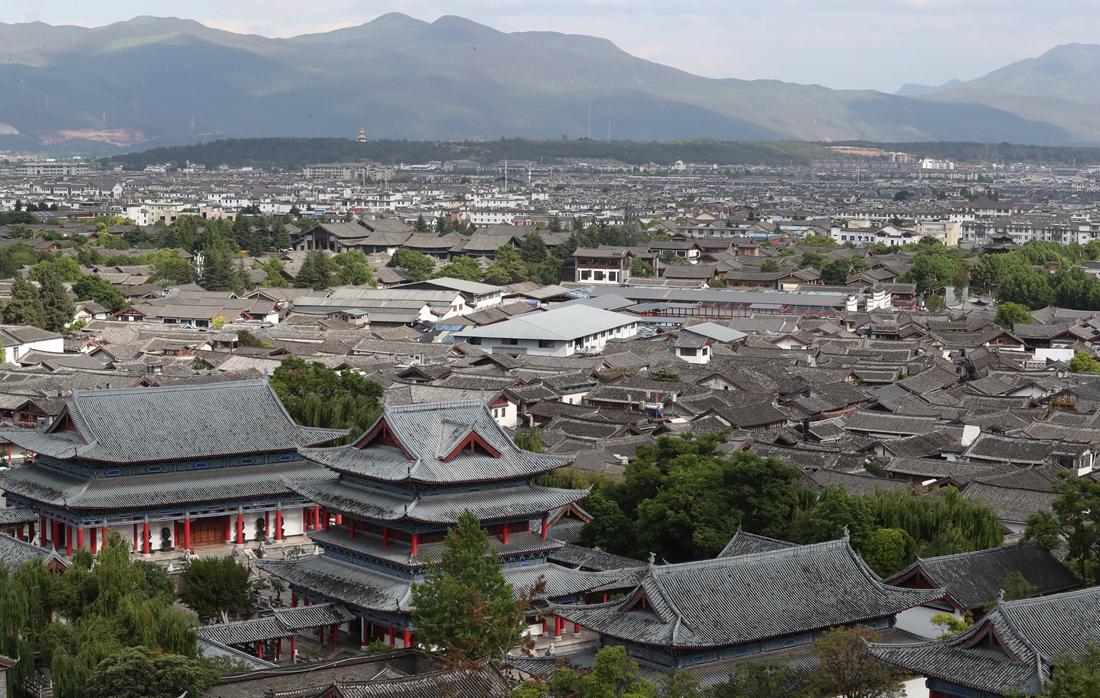
An overview of the Lijiang Old Town amidst the mountains of northwestern Yunnan
A journey into World Cultural Heritage
Tucked amidst the mountains of northwestern Yunnan, Lijiang Old Town emerges as a serene, wall-less ancient city. Babbling streams whisper through its winding bluestone paths, which seem to unfurl like living poetry. The timeless melody of ancient Naxi music gently fills the air.
Dating back over 800 years, Lijiang Old Town’s origins are rooted in its strategic location at a bend of the Jinsha River, historically known as the Lijiang River, from which the town derives its name. Today, Lijiang Old Town collectively refers to Dayan Old Town (its main component), Baisha Residential Complex, and Shuhe Residential Complex. The distinct residential buildings within the city are predominantly courtyard-style, beautifully integrating the cultural characteristics of multiple ethnic groups, including Han, Bai, Yi, Zang, and Naxi.
Water is the lifeblood of Lijiang Old Town; as a beautiful saying goes, streams flow to every household, and weeping willows graces every home. The astute ancient Naxi people ingeniously channeled underground springs to create their distinctive “three-eye wells.” These wells feature three distinct pools, built according to elevation differences: the uppermost for drinking, the middle for washing vegetables, and the lowest for laundry. This age-old tradition of revering and conserving water continues to be meticulously upheld by the local residents today.
Where mountains embrace water and the people live in harmony with their city, Lijiang Old Town earned its place on the World Cultural Heritage List in 1997. Its profound value is not merely embedded in the ancient stones, plants, and structures, but vibrantly pulsates through the daily lives of its inhabitants. Demonstrating this living heritage, numerous old courtyards have been thoughtfully restored and brought back to life. Notable among these are the Former Residence of Fang Guoyu, the Heaven and Earth Courtyard, the Heng Yu Gong Folk House Museum, and the Naxi Hieroglyphics Painting Experience Center. To date, Lijiang Old Town has fostered over 30 such cultural courtyards, establishing dynamic new platforms for cultural preservation and offering visitors enriched perspectives for a deeper understanding of its unique spirit.
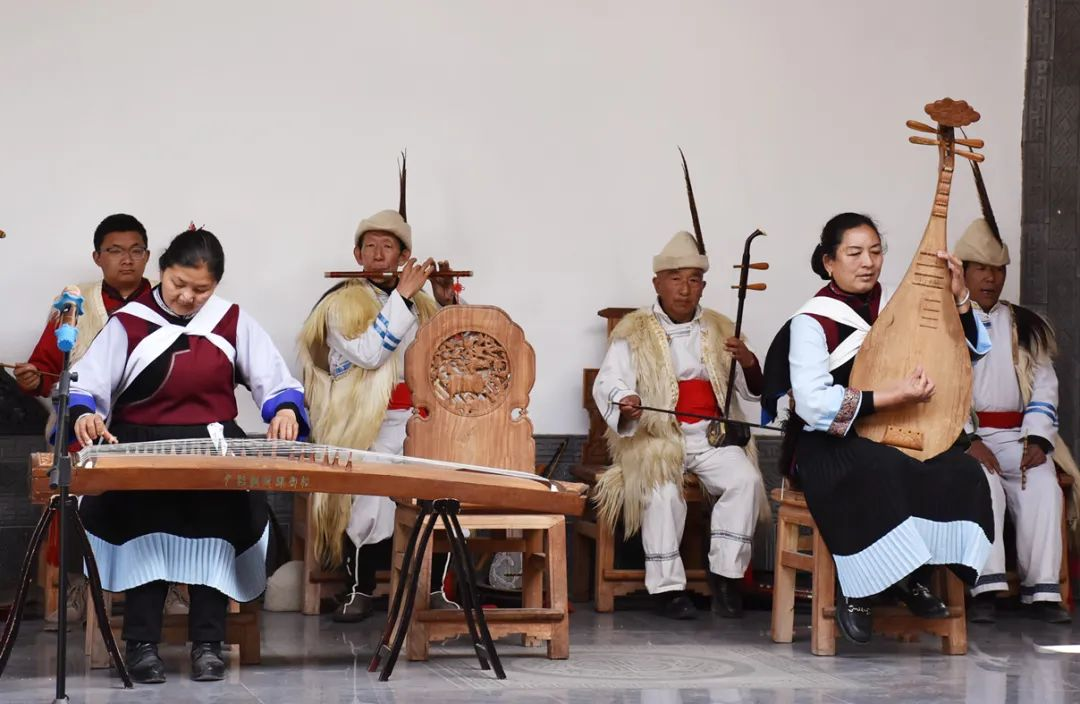
Naxi folks in Lijiang perform the refined Baisha music.
Simultaneously, with the evolution of the times, digital technologies like 5G, the Internet of Things (IoT), big data, and artificial intelligence have seamlessly integrated into every corner of the ancient city. These collectively form the “smart brain” of Lijiang Old Town, enabling innovative solutions: noise monitoring equipment linked with smart broadcasting automatically prompts visitors for quiet, AR (Augmented Reality) provides real-time navigation, smart restrooms display live vacancies, facial recognition allows “zero-contact” entry, and unmanned retail stores offer automatic checkout. Thanks to these technological advancements, the daily management of the old town has become remarkably more efficient, and safety and order are better maintained. Moreover, new business formats, including charming homestays, slow-paced tea and coffee experiences, and dedicated travel photography services, have rapidly emerged, drawing an increasing number of visitors who seek to immerse themselves in the authentic daily life of the ancient city.
Located where Yunnan, Sichuan, and Xizang converge, Lijiang Old Town historically functioned as a crucial hub on both the Southern Silk Road and the Ancient Tea Horse Road. This central position made it a vibrant trading post where goods flowed: horses, wool, leather, and medicinal materials arrived from the Qinghai-Xizang Plateau, while tea, ironware, salt, sugar, and grains were channeled in from the interior regions, all gathered and distributed within its bustling markets.
Lijiang Old Town’s prosperity was fundamentally driven by its vibrant trade routes and flourishing commerce. Uniquely, the true heart of this ancient city was not the Mu Family Mansion, the traditional seat of power, but rather its bustling commercial nexus: Sifang Street (Square Street). This central marketplace, easily accessible from every direction, teemed with countless shops and was a constant convergence point for merchants. Crucially, the absence of defensive city walls allowed horse caravans to freely enter the ancient city from all sides, remarkably streamlining the flow of goods and fostering its economic dynamism.
While the horse caravans that once plied the Ancient Tea Horse Road have long since vanished, Lijiang Old Town remains a thriving metropolis. It artfully combines serene tranquility with lively dynamism, offering a captivating experience day and night. The city boasts a rich tapestry of business formats, including diverse dining options, cozy accommodations, professional travel photography, intricate handicrafts, and compelling performing arts. Leveraging new technologies like artificial intelligence, scenic area management and services have become remarkably smarter. Within this vibrant ecosystem, over 20,000 original residents, more than 5,000 active merchants, and tens of millions of annual tourists coexist, fostering a unique and harmonious urban narrative.
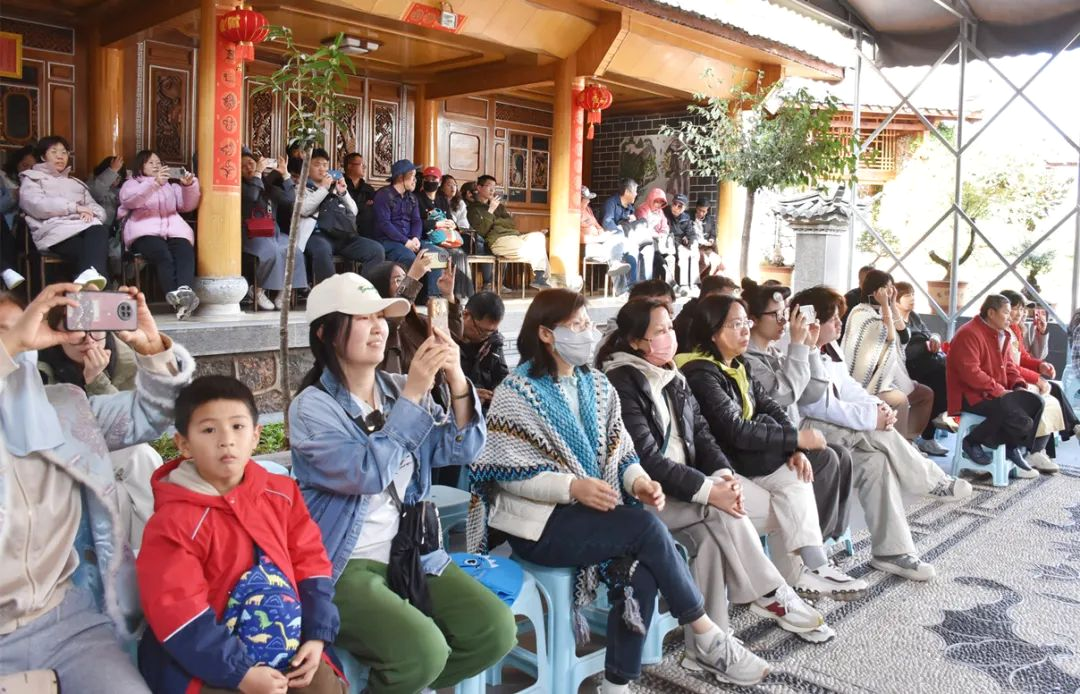
Tourists listen to the refined Baisha music by Naxi folks in Lijiang.
A landscape painting through the seasons
In 2011, after resigning from a company in Shanghai, Shen Weiwei and her husband Liu Yongqiang became “backpackers.” They would choose their desired destinations, pack their bags, embark on journeys, and experience the local customs and cultures of different places. Lijiang was one stop on their travels. Upon their first encounter with Lijiang, its mountains and waters captivated them, making them reluctant to leave. When they revisited Lijiang, they decided to stay and opened a dessert shop there.
For Shen Weiwei, Lijiang mirrors the idyllic vision of Tao Yuanming’s “The Peach Blossom Spring” — a place so captivating one never wishes to depart. She notes a distinct difference from other urban centers. “Every day, as soon as you open your eyes,” Shen Weiwei explained, “you are greeted by sunshine, blue skies, white clouds, and snow-capped mountains.” She emphasized that the unique ability to witness these majestic peaks from various angles within the city is truly “one-of-a-kind” to Lijiang. A significant personal reason for her decision to reside there is the omnipresent Yulong Snow Mountain. In traditional Naxi culture, Yulong Snow Mountain is not merely a landmark but a revered sacred mountain, carrying the ancient weight of time and standing as a perpetual protector of local life.
As Shen Weiwei beautifully describes, Yulong Snow Mountain is the very soul of Lijiang’s natural splendor. This majestic range is perpetually crowned with snow and cradles the modern oceanic glacier closest to the equator on the Eurasian continent. Its thirteen towering peaks soar like a procession of silver dragons, with the primary summit, Shanzidou, reaching an impressive elevation of 5,596 meters. At its base, the alpine meadows transform with each passing season, presenting a breathtaking spectacle: a vibrant sea of rhododendrons in spring, rare Meconopsis blooms in summer, golden pine forests ablaze in autumn, and delicate rime ice crystals adorning winter. Together, these seasonal transformations create an unparalleled visual feast that captivates visitors, making them wish to linger indefinitely.
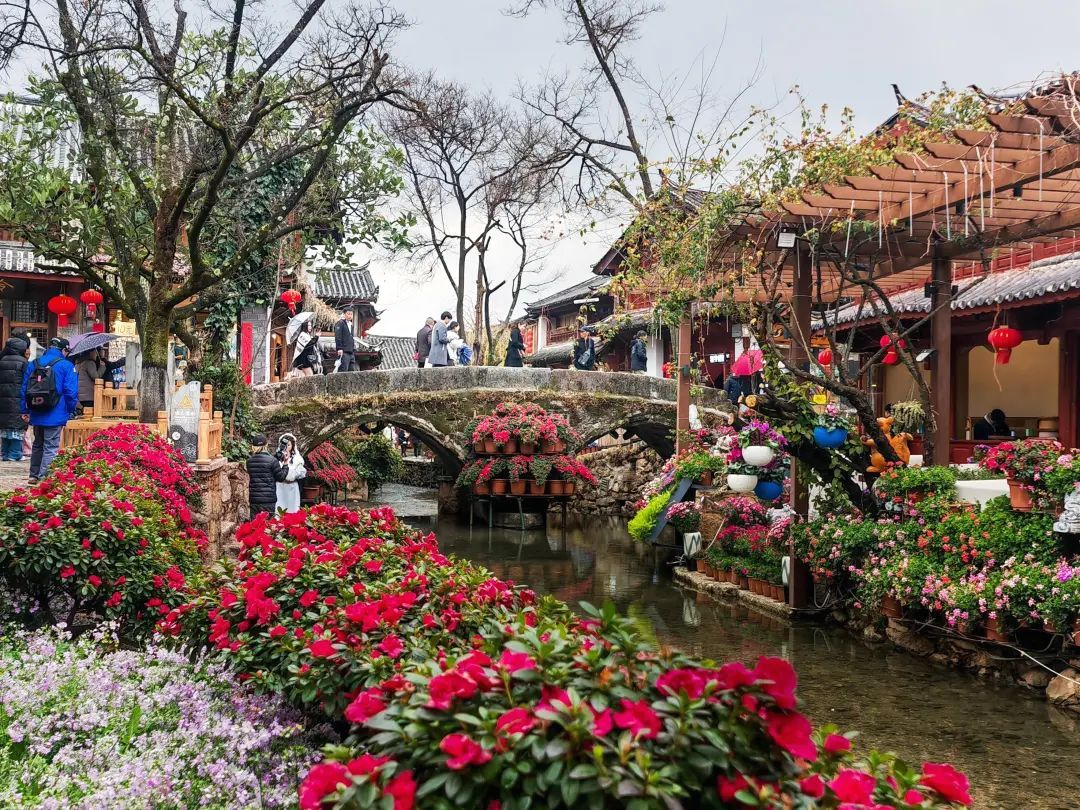
A view of the Lijiang Old Town
Laojun Mountain, a pivotal component of the “Three Parallel Rivers of Yunnan Protected Areas” World Natural Heritage site, is majestically situated in the western expanse of Yulong County, Lijiang City, nestled between the Jinsha and Lancang Rivers. This region proudly hosts the most extensive and fully developed Danxia landform cluster in China. Its concentrated and spatially proximate geological features create a unique optical illusion, allowing observers to witness the sun rising and setting three times within a single day — a phenomenon that makes it a coveted destination for photography enthusiasts. At the Geladan Scenic Area within Laojun Mountain, photographer Shi Xiongfei expertly captured its captivating allure. “Geladan possesses a unique beauty in every season,” remarked Shi Xiongfei. “The mountains, when intertwined with mist and clouds during rainfall, take on an ethereal charm. I’ve visited and photographed here many times, and each occasion has yielded abundant, breathtaking rewards.”
As one of Yunnan’s nine majestic plateau lakes, Lugu Lake finds its home within the Yalong River system of the Jinsha River basin. A truly enchanting spectacle unfolds annually from May to October, when countless delicate, crystal-clear Haicai (Ottelia acuminata) unfurl across its surface, transforming the lake into a vibrant, ethereal garden. To embark on a traditional “pig-trough boat” — a distinctive local dugout canoe—and drift through this blooming aquatic landscape on Lugu Lake is to discover a serenity akin to an earthly paradise. Doufatuma, a visitor hailing from Xinjiang, was utterly captivated by Lugu Lake’s magnificent beauty. So overflowing with happiness, she spontaneously danced a traditional Xinjiang dance on the balcony of her guesthouse. “I’ve been staying in Lugu Lake for a while now,” she said, her enthusiasm evident. “The climate is good; the scenery is beautiful. My guesthouse in Daluoshui means I can enjoy the beautiful view of Lugu Lake just by opening the window. The facilities are good too; it’s a great place to live and travel.”
Lashi Lake, known locally as Lashihai (meaning “Lashi Sea”), is the largest plateau lake in Lijiang and holds the distinction of being Yunnan Province’s first nature reserve designated as a “wetland.” Now is arguably Lashi Lake’s most captivating season. As you journey along the Lake Shore Road, wild roses bloom in a profusion of color, offering a cheerful welcome. Visitors can choose to serenely glide across the calm lake in a small boat, observing birds gracefully skimming the water, or opt for a horseback ride along the ancient Tea Horse Road, exploring its rich history and legends. For a more relaxed experience, setting up a tent on the lakeside grassland for a pleasant picnic is also an option. In winter, Lashi Lake transforms into a paradise for migratory birds. Numerous species like grey geese, mallards, common coots, and wild cormorants gather in the shallow waters, presenting a dynamic and lively spectacle as they swim, forage, fly, and play—a testament to the rich ecological diversity of this plateau wetland.
Read More:
On February 12, Lijiang unveiled its first dedicated sightseeing train route: the Lijiang Snow Mountain Sightseeing Train. This impressive panoramic mountain tourist train, developed entirely in China, operates along a 20.7-kilometer route and boasts a top speed of 70 kilometers per hour. It seamlessly connects major tourist attractions and popular photo opportunities, including Baisha Ancient Town, Yushui Village, Dongba Valley, and Ganhaizi. Taking approximately 35 minutes from its starting point to the terminal, the journey allows passengers to fully immerse themselves in the breathtaking beauty of Lijiang.
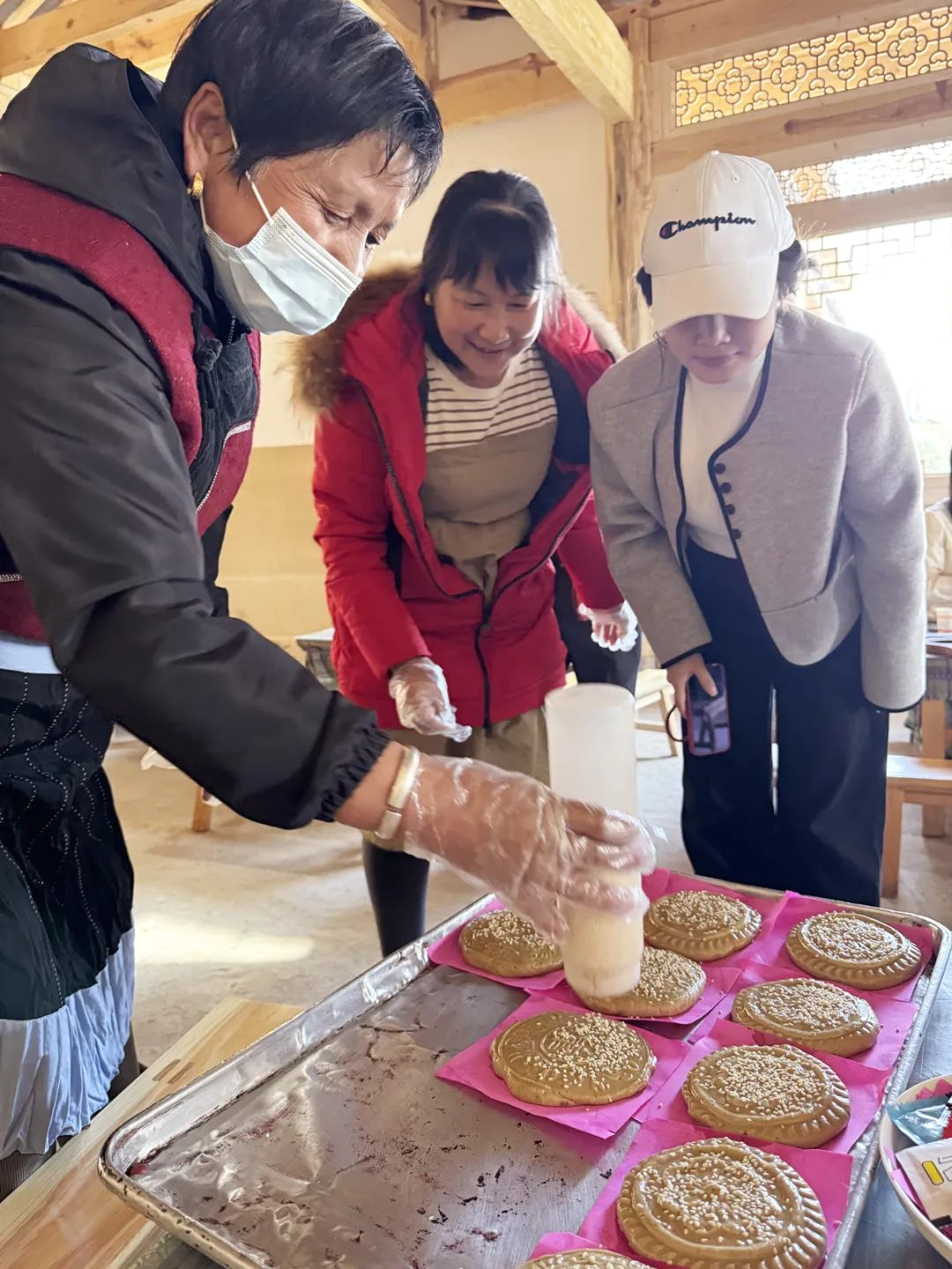
Tourists learn about how to make the Naxi cake in Lijiang.
A one-day Naxi experience
Stepping into Changshui Village, an ancient Naxi village embraced by spruces, one immediately noticed a wisp of smoke curling from the tile cats and other roof guardians of a quadrangle courtyard. At the antique courtyard’s entrance, the Naxi host, dressed in traditional Pixing Daiyue attire, symbolically representing “wearing stars and moon,” and a sheepskin waistcoat, led their whole family in Naxi folk songs, warmly greeting visitors.
Once inside the courtyard, visitors changed into Naxi attire, seamlessly beginning their immersive “one-day Naxi experience.”
In the early morning, sunlight streamed into the courtyard, filled with the sounds of birds and the fragrance of flowers. The diligent and kind hostess, Naxi Grandma, had already prepared ingredients such as wheat flour and sugar. Wang Lei, an engineer from Shenzhen, and his family of three were following the hostess, wrapping rose and brown sugar filling into dough. “Be as gentle as possible with your hands; if you press too hard, it won’t come out,” Naxi Grandma said, holding a century-old carved wooden mold, demonstrating and reminding them. As the Naxi celebratory cake dough, adorned with auspicious Eight Treasures patterns, was carefully lifted from the mold, the 10-year-old boy gasped in delight. A perfect flower was imprinted on the soft cake surface. “Mom, look! I can make cakes now!” he exclaimed.
This traditional pastry, infused with history and culture, offered visitors a hands-on opportunity to delve into the unique culinary traditions of the Naxi people through the very acts of kneading and baking. Hangzhou food blogger Nida was particularly impressed, extending her trip specifically to film the creation of these Naxi celebratory cakes. “While modern baking relies on precise measurements,” she noted, “Naxi Grandma’s mastery of dough fermentation comes from the intuition of her fingertips. That inherited culinary wisdom is truly invaluable.”
Beneath the blue-tiled eaves, an ancient stone mill stood poised. The hostess, with practiced ease, added soaked soybeans into its opening. Gripping the handle firmly with both hands, she began to turn the heavy millstone. Slowly, a creamy, milky white stream of soy milk emerged from between the grinding stones, captivating the surrounding tourists with its traditional charm.
Li Shuhua, a retired teacher from Beijing, eagerly volunteered her turn. As she concentrated on the rhythmic push of the mill handle, she remarked, “This reminds me of helping my mother make tofu as a child. The Naxi ancestors’ ingenuity in using coagulants truly embodies a remarkable wisdom of coexistence between humanity and nature.”
Bathed in afternoon sunlight, the century-old house hosted a scene of quiet tradition. By the fire pit, an old Dongba priest painstakingly rendered ancient pictographic Dongba characters, one meticulous stroke after another. “This symbol represents ‘man,’ distinguished by a hat; and this one, ‘woman,’ adorned with a flower. Isn’t that wonderfully evocative?” a French tourist observed, tracing the characters. “Dongba script uniquely condenses the Naxi ancestors’ profound understanding of the world into over 2,000 symbols. Its poetic depth, I find, surpasses even Mayan script.”
As twilight dyed the snow-capped mountain peaks red, He Linyi, a representative inheritor of Baisha Xiyue (Baisha Ancient Music)—a national-level intangible cultural heritage project, prepared a wonderful performance with his entire family.
The performance took place right in He Linyi’s own courtyard, with his family members making up the band. For over 20 years, he has led the Baisha Xiyue folk band to perform and exchange in renowned music venues such as the National Centre for the Performing Arts and the Central Conservatory of Music. They have also performed in countries like Hungary, Germany, Slovakia, Belarus, and Russia. He was personally appointed as a visiting expert by the School of Art at Yunnan Minzu University. In recent years, he has started a Baisha Xiyue inheritance training class in his own small courtyard.
Dressed in his sheepskin waistcoat and felt hat, He Linyi greeted the tourists in his small courtyard with a warm smile, effortlessly hosting them in English, Chinese, and Naxi languages. His quick wit and humorous anecdotes frequently erupted in laughter from his audience. Yet, as the exquisite sounds of Baisha Xiyue began to fill the space, a profound silence descended upon the guests, who became utterly captivated by the drifting melodies of the classical music.
“The harmonics of the sanxian (three-stringed lute) perfectly resonate with the flute’s melody; it’s more moving than any concert hall performance,” a music teacher remarked. “Listening to ancient Naxi music in a Naxi courtyard creates a truly unique atmosphere.”
As night fell, bonfires cast a warm, dancing glow across the village. Tourists and villagers, arms linked, joyfully whirled in a traditional group dance known as “datiao,” their movements synchronized to the enchanting “Alili” flute melody. Reflecting on their “one-day Naxi experience,” one tourist later wrote on social media: “Tonight, in this ancient Naxi village, we rediscovered the collective memories long lost in the city. The cultural richness preserved by the Naxi people—through their fire pits, songs, dances, and ancient scriptures—might just be the perfect balm for modern souls seeking self-healing.” (The photos featured here are sourced from the Lijiang Integrated Media Center.)
Text by our staff correspondents
Translated by YNTA
Proofreading by Zu Hongbing